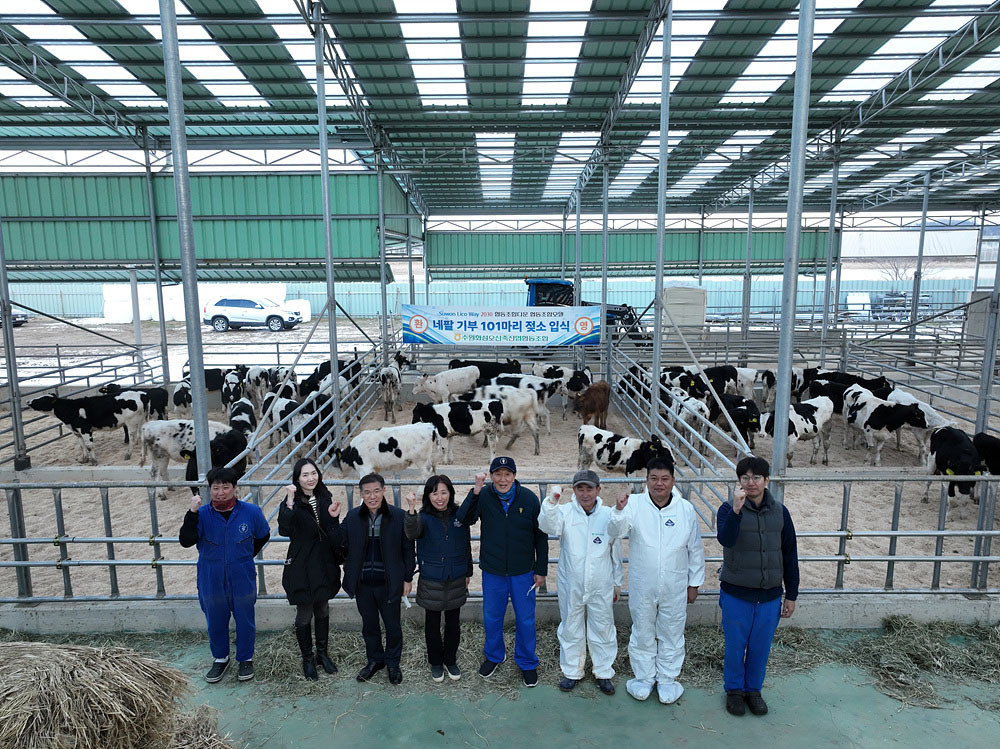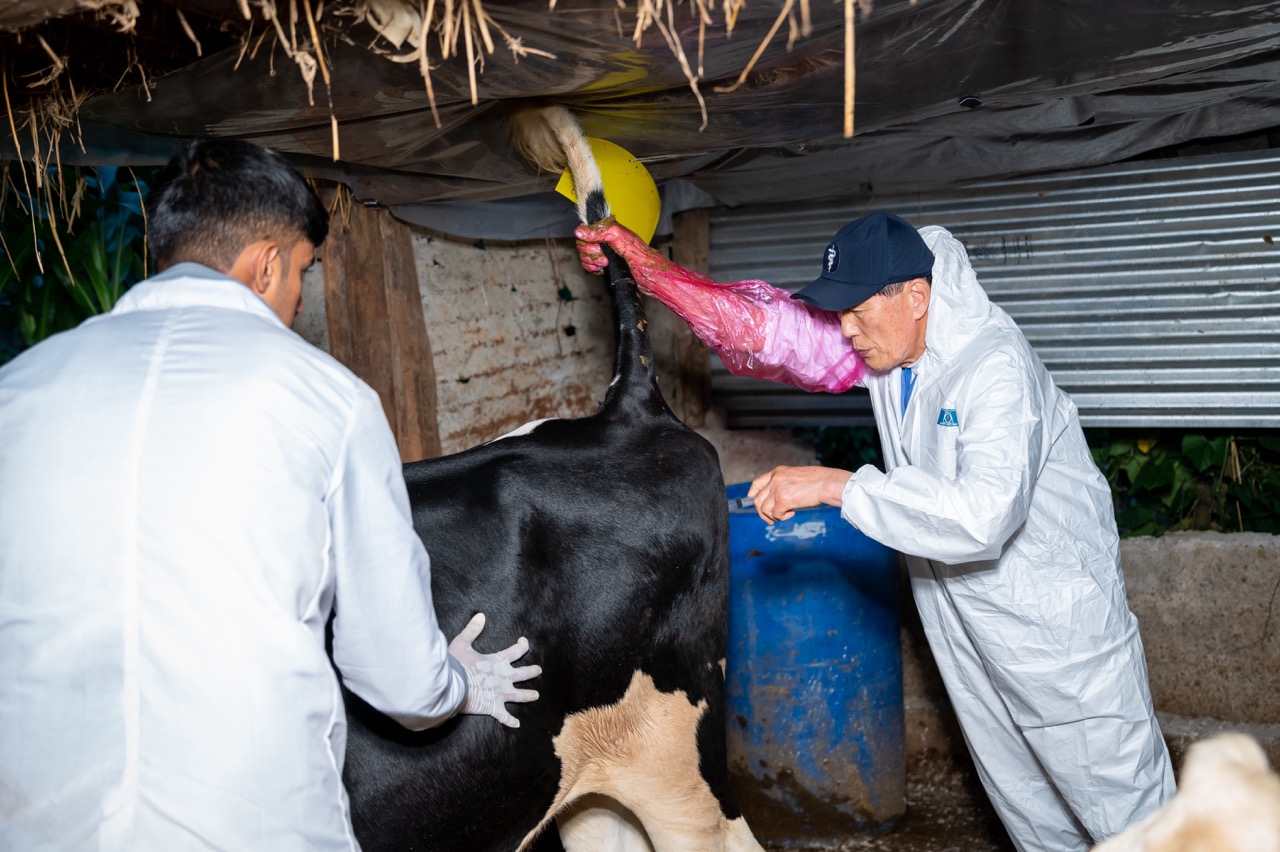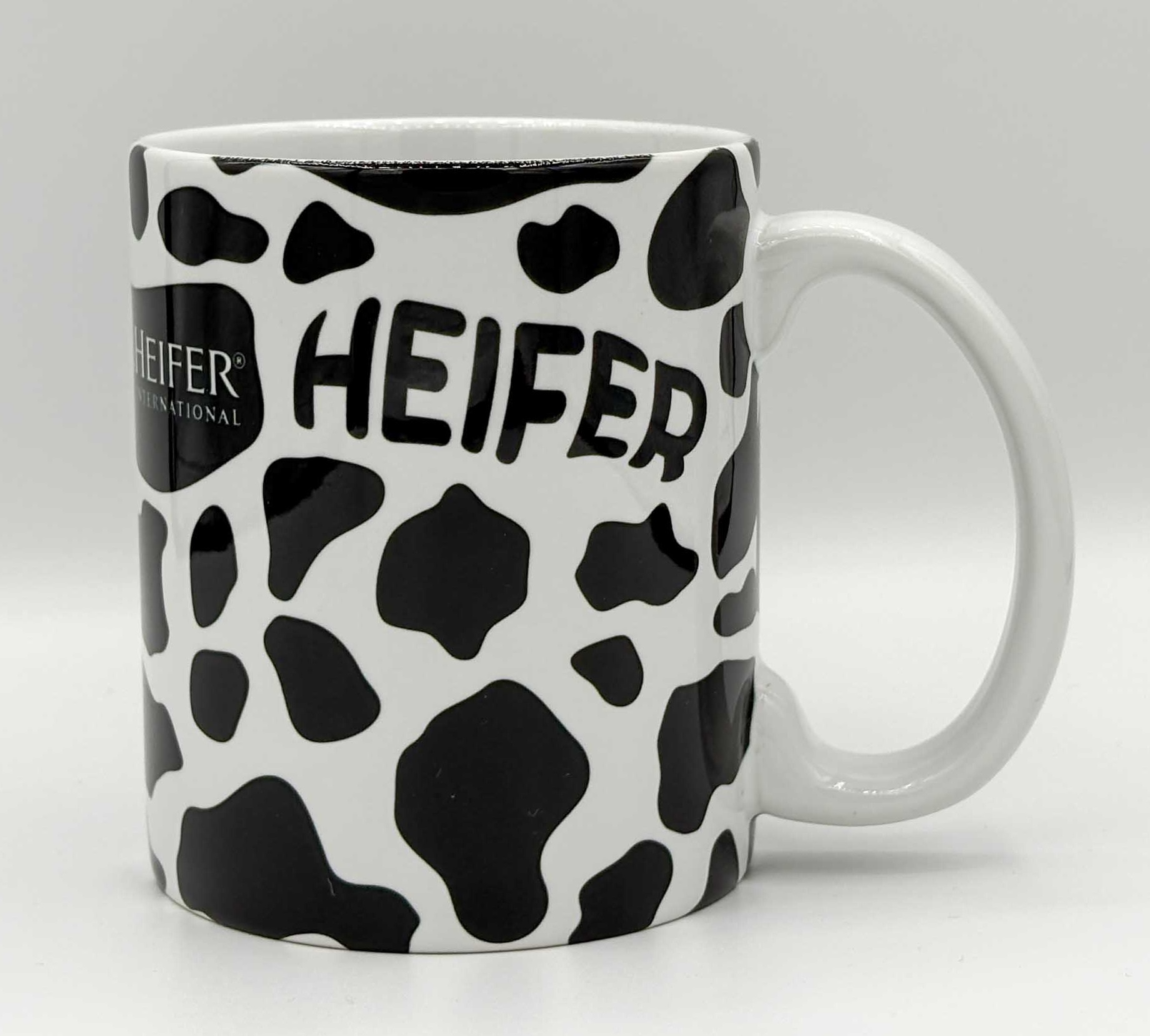A Conversation with Jaebok Lee, Heifer Recipient Turned Donor
By Haewon Lee | September 11, 2024
November 13, 2024
For over a half-century, Dr. Youngchan Kim has been dedicating his life to developing a preventive health care system for dairy cattle in South Korea to manage diseases with the goal of enhancing income for dairy farmers.
Today, in addition to an esteemed ongoing veterinary career in Korea, Dr. Kim serves as the lead Korean veterinarian for the Milky Way Signature Program, a joint initiative of the government of Nepal, the government of South Korea and Heifer International to transform Nepal’s dairy sector.

The program was catalyzed in December 2022 by the transfer to Nepal of 100 Holstein heifers and eight high-quality breeding bulls donated by Korean dairy farmers, with Dr. Kim providing essential oversight and training for Nepali farmers to ensure the long-term health and productivity of the animals. Below, Dr. Kim shares his expertise and experience as a key figure in this momentous initiative.
I was introduced to Heifer and Heifer’s legacy in Korea by Ms. Haewon Lee, executive director of Heifer Korea. Within 10 minutes into the first meeting at my clinic, Ms. Lee sought advice on obtaining a health certificate to export cattle from Korea to Nepal. She explained about Heifer Korea’s plan to ship live cattle to Nepal.
To my surprise, she was facilitating the negotiation between the two countries to develop a quarantine agreement to export bovine semen and cattle. I gave her a list of bovine-related diseases that must be included in the health certificate for animal quarantine, and after a few months of negotiations, she informed me that the health certificate was approved. Such a process, I know, usually takes about three to five years, so when she brought that news to me, that is when I began to believe that the shipment of live cattle from Korea to Nepal may be possible.
The next step was to develop a blueprint for the procurement and shipment. No one in Korea had done what she was planning to do, so as expected, there were many hurdles and challenges. One thing she emphasized over and over, throughout the planning stage, was her plead to develop a health safety plan to ensure good health and safety of all 108 heifers and bulls. Nepali smallholder farmers, she said, were eagerly waiting for the historic gift from Korea.

My vet team at the clinic spent many hours to create a customized health management and disease control protocol. Our primary objective was for the Korean heifers to survive and multiply in Nepal. In addition to the health certificate required vaccines, they also received special veterinary services including vaccines to prevent respiratory issues that may be triggered during a long journey and finally to their new homes in Sindhuli [the site of the Milky Way “Model Dairy Village,” the community of recipient smallholder dairy farmers in Nepal which serves as the program’s center of excellence in dairy husbandry].
Many agonizing hours we spent to develop health safety measures, simulating many scenarios for unexpected conditions in transportation and local adaptation.
The situation in Sindhuli today reminds me of how it was in Korea in the 1970s. In the early days of my veterinary practice, I would set out for a farm visit only when an emergency call comes in. I would travel on foot, from one farm to another. In Sindhuli, making house calls from one village to another, meeting and talking to the recipients of Korean heifers brought back memories and warmed my heart.
Korean smallholder farmers, in early days of dairy farming, I remember, eagerly waited for my examination to finish and listened attentively to my diagnosis, many times with concerned eyes, fearing for any bad news. I saw the same concern and joy in Sindhuli farmers. I am not based here, so when I come to Sindhuli I try to visit as many households as possible, sometimes starting as early as 5 a.m. They eagerly wait and listen, holding on to every advice I give.
Sindhuli farmers are diligent and committed to learn and provide the best care for Korean heifers. This is very important. Korean heifers’ well-being depends on not only receiving timely veterinary services, but also on individual farmers’ commitment and persistence to give 24 hours/365 days care. The success we see today in the Sindhuli Model Dairy Village is because of the farmers and the concerted community efforts.

To provide proper veterinary care for the Korean heifers, we had to create a field-practicing team of Korea-Nepal vets. Initially, when I arrived in Sindhuli, there was only one vet technician, Bibek Koirala, available in the field. Compared to buffalos or local breeds, the Korean Holstein has the capacity to give 10 times or more milk production, which means customized special care around the clock is required. The 100 heifers are the only pure Holstein available in Nepal. Building veterinary capacity and field training for local vets and vet technicians, I saw, was an immediate need.
Each time I come to Sindhuli, I allocate time for field training for Bibek and farmers on basic but critical practices in health management and biosecurity. This is as simple as practicing “one needle for one cow” during vaccinations and washing hands to prevent the spread of disease. Last May, when there was an outbreak of lumpy skin disease in Sindhuli, Heifer Korea suggested and activated a 24-hour Sindhuli Vet Hotline via WhatsApp so the field team could reach out to me around the clock. They would report the situation via calls and video conferencing, and then we would consult together to provide a timely treatment. Fortunately, a localized treatment protocol was developed and administered, and because of teamwork, together, we saved the lives of Korean heifers and local cattle as well.
To increase fertility rates, most countries use hormone-synchronized artificial insemination technique, which is not widely used in Nepal. This technique we transferred over to the Nepali field team by sending Korean experts to train in the field. Also, Korean veterinary medicine companies, learning about this project, donated necessary hormones manufactured in Korea. Together — artificial insemination specialists from Korea and two local specialists — we completed the task 100 percent.
Last year, after the lumpy skin disease, many farmers feared for infertility. Statistics in Pakistan show less than 10 percent of lumpy skin affected cattle became fertile. So, when vets confirmed the Korean heifers were pregnant with ultrasonic pregnancy diagnostic equipment we brought last fall, the whole community was genuinely kushi (happy). After so many challenges and tireless work in the field, the recent birth of more than 50 calves is a living testament to the Korea-Nepal vet team working together. I am truly grateful for the opportunity to partake in this historical journey and to pass on 55 years of veterinary knowledge and experiences to my friends and colleagues in Nepal.
With the birth of Korean calves, I can confidently say that the farmers and the Heifer field team have now experienced one full cycle of pure Holstein cattle. The full spectrum of livestock management knowledge and experiences, including feeding at different stages; diseases and health management, biosecurity and preventive health system, including washing hands and vaccination; artificial insemination techniques; shed management; and livestock data recording, have been transferred over by the Korean experts during the past two years of making regular field visits under the supervision of Heifer Korea.
Cart is empty
Success!
Please be patient while we send you to a confirmation page.
We are unable to process your request. Please try again, or view common solutions on our help page. You can also contact our Donor Services team at 855.9HUNGER (855.948.6437).
Covering the transaction fee helps offset processing and administrative fees that we incur through taking payments online. Covering the transaction fee for each payment helps offset processing and administrative fees that we incur through taking payments online. Covering the transaction fee for each payment helps offset processing and administrative fees that we incur through taking payments online.
Success!
Please be patient while we send you to a confirmation page.
We are unable to process your request. Please try again, or view common solutions on our help page. You can also contact our Donor Services team at 855.9HUNGER (855.948.6437).
When you donate a gift to someone, you'll have the option to create a free card after your donation is complete.

A FREE gift will be sent to supporters who choose to give a monthly gift.
Covering the transaction fee helps offset processing and administrative fees that we incur through taking payments online. Covering the transaction fee for each payment helps offset processing and administrative fees that we incur through taking payments online. Covering the transaction fee for each payment helps offset processing and administrative fees that we incur through taking payments online.

A FREE gift will be sent to supporters who choose to give a monthly gift.